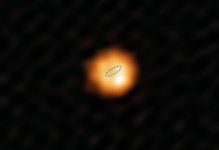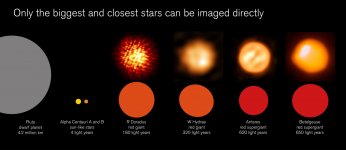Just an illusion or is there a physical example?Without puffing myself up, I am indubiatably in the top 1%. My Mathematics Master, Quint, used to say " I am frequently impressed with the conciseness that Steve solves Definite Integrals involving the substitution of a complex variable."
My Chemistry Master, Mike, took an altogether dimmer view. He would dock me Marks on my Precise Calculations on Gas Variables like Pressure, Temperature and Heat.
"How come you docked me Marks when I got the Right Answer?" I said.
Because (Mike Said) you did not mention Avogadro's Hypothesis.
"Why should I care about Avogadro?" I replied. "You either understand Entropy, or you don't!"
Anyway, I went on to get Merit in the Special Chemistry Paper. But, TBH, not my favourite subject.
MY FAVOURITE SUBJECT is the Geometry of Space-Time!
Just as a teaser, here are the Borromean Rings:
View attachment 1038509
No ring is actually looped to any other, but the whole thing hangs together. Weird, huh.
Indeed. The inflationary epoch could not be sustained with the post inflationary epoch’s c constraint.Yes, that's an excellent reference source and, keep it under your hat, one from which I have often quoted.
There's one discrepancy though - the inflationary period is now postulated to have occurred before the big bang rather than after it.
When and how did this sudden realization come to c?Indeed. The inflationary epoch could not be sustained with the post inflationary epoch’s c constraint.
Okay, but my question is "when did the former explanation change to the current view" and what prompted it?Because during the inflationary epoch the universe expanded faced than c
Surely you know by now that Steve knows his onions! 😎Just an illusion or is there a physical example?
Actually, that was two questions...but my question is...
He may have have just discovered a new dish!Surely you know by now that Steve knows his onions! 😎
Surely you can handle two at a time?Actually, that was two questions...
your audience awaits!
Okay, but my question is "when did the former explanation change to the current view" and what prompted it?
Your questions are not clear, Pete, as you are not quoting the relevant parts of previous posts.
Perhaps you are referring to the view of whether inflation came before or after the big bang.
Cosmic inflation was first proposed and refined during the early-to-mid 1980s. The big bang was once traced back to a singularity, but now we trace it back to an inflationary state that preceded it.
Ethan says that those who disagree that inflation came first are "40 years out of date".
https://www.forbes.com/sites/startswithabang/2019/10/22/what-came-first-inflation-or-the-big-bang/
The inflationary epoch preceeding the BB is discussed in the updated ‘The First Three Minutes’ (Which I am going to reread - highly recommended). It was Alan Guth that proposed Inflation IIRC.
Seems the inflationary epoch (ie pre BB) could have existed for a very long time according to Ethan Since the size of the universe was asymptotic - very small, but not zero.
So why can't we get images like that close up of our Sun? There is no sharp focus on the body of that star.
Ever eager to please, Pete, I've found out more about our ability to resolve the images of stars!
In 2017, details on the surface of a star with the same mass as the Sun were observed for the first time. Star W Hydrae is larger than the Sun though, with a diameter equal to twice the size of Earth's orbit around the Sun. The dotted line on the image of W Hydrae (see first attachment) shows the size of the Earth's orbit around the Sun, seen from an angle.
Hitherto, details have only been seen on much more massive, red supergiant stars like Betelgeuse and Antares, as shown in the second attachment.
The image of W Hydrae was taken by ALMA (Atacama Large Millimeter Array) which is an astronomical interferometer comprising 66 radio telescopes in the Atacama Desert of northern Chile.
OK, the image of W Hydrae does not look spectacular to the layman, but to astronomers the presence of a compact, bright spot provides evidence that there is a surprisingly hot layer of gas above the star's surface.
Attachments
Prof Ian Morison has a good discussion about the problems of resolving stars in any great detail with either optical or radio telescopes in his book 'Introduction to Astronomy and Cosmology'. Might be JW gives us some better images, but essentially you are trying to resolve a pinprick of light with rays that are effectively in parallel - a completely different challenge to that of a microscope.
He has a blog here http://www.ianmorison.com/ - hasn't been updated for a while as far as I can tell, but there's some interesting stuff.
He has a blog here http://www.ianmorison.com/ - hasn't been updated for a while as far as I can tell, but there's some interesting stuff.
Thanks, Morison's blog will be of interest to all earth-bound amateur astronomers.
Suffering just slightly from the problem myself, I read his blog on "Cataracts - an astronomer's story", and rather wish I hadn't!
Here's an extract from his book:
Suffering just slightly from the problem myself, I read his blog on "Cataracts - an astronomer's story", and rather wish I hadn't!
Here's an extract from his book:
"We have no knowledge of what lies in the cosmos beyond the horizon of our visible universe. Different regions could have different properties; these regions could be regarded as different universes within the overall cosmos. Our part of the cosmos is, like baby bear’s porridge, just right."
Give Galu's ramblings about the "Anthropic Principle" as many likes as you like. It doesn't make it right.
Pure unknown Ed Witten's M-Theory. Prosetylised by those String Theory villains at Stanford. Not even Wrong! 🙄
I have learned something most interesting from Planck Units. Energy is proportional to the inverse of Distance.
That is: E= A x 1/R. Which means the more you confine a particle, or a couple of photons, the higher the energy! It's obvious really.
The photons can even become electron-antielectron pairs or even Mesons. This is what QED deals with.
I have been considering whether Space-Time itself might have structure, aside from the particle Zoo.
Just about got it. Naturally this a 2D Manifold embedded in 3 Space. For the big picture, we need 3 dimensions in 4-Space.

I think I have just created the minimal Black Hole. Each wormhole is a unit of information. Proportional to the area of the Black Hole, so predictive.
I always said Black Holes were Tori. I amaze myself sometimes. 😎
Pure unknown Ed Witten's M-Theory. Prosetylised by those String Theory villains at Stanford. Not even Wrong! 🙄
I have learned something most interesting from Planck Units. Energy is proportional to the inverse of Distance.
That is: E= A x 1/R. Which means the more you confine a particle, or a couple of photons, the higher the energy! It's obvious really.
The photons can even become electron-antielectron pairs or even Mesons. This is what QED deals with.
I have been considering whether Space-Time itself might have structure, aside from the particle Zoo.
Just about got it. Naturally this a 2D Manifold embedded in 3 Space. For the big picture, we need 3 dimensions in 4-Space.
I think I have just created the minimal Black Hole. Each wormhole is a unit of information. Proportional to the area of the Black Hole, so predictive.
I always said Black Holes were Tori. I amaze myself sometimes. 😎
- Status
- Not open for further replies.
- Home
- Member Areas
- The Lounge
- What is the Universe expanding into..

